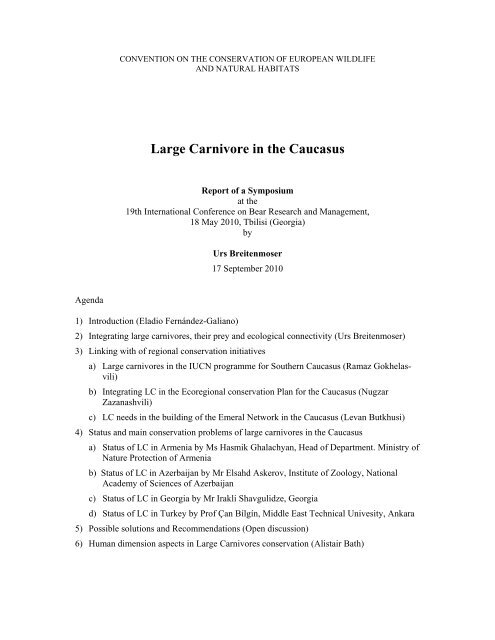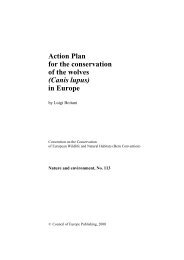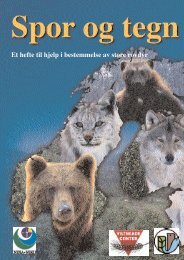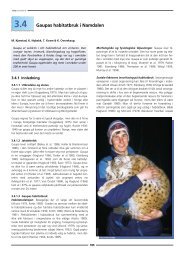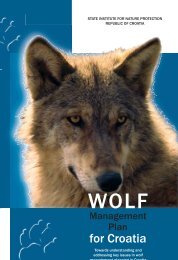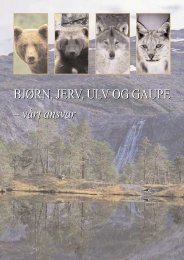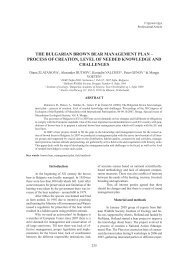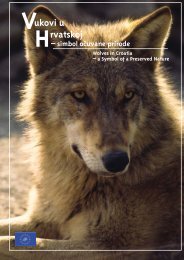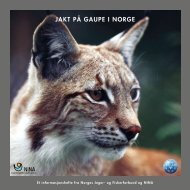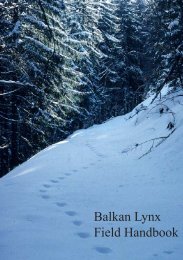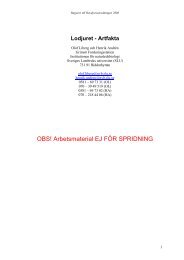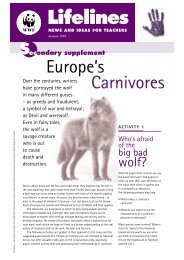Large Carnivore in the Caucasus
Large Carnivore in the Caucasus
Large Carnivore in the Caucasus
Create successful ePaper yourself
Turn your PDF publications into a flip-book with our unique Google optimized e-Paper software.
CONVENTION ON THE CONSERVATION OF EUROPEAN WILDLIFEAND NATURAL HABITATS<strong>Large</strong> <strong>Carnivore</strong> <strong>in</strong> <strong>the</strong> <strong>Caucasus</strong>Report of a Symposiumat <strong>the</strong>19th International Conference on Bear Research and Management,18 May 2010, Tbilisi (Georgia)byUrs Breitenmoser17 September 2010Agenda1) Introduction (Eladio Fernández-Galiano)2) Integrat<strong>in</strong>g large carnivores, <strong>the</strong>ir prey and ecological connectivity (Urs Breitenmoser)3) L<strong>in</strong>k<strong>in</strong>g with of regional conservation <strong>in</strong>itiativesa) <strong>Large</strong> carnivores <strong>in</strong> <strong>the</strong> IUCN programme for Sou<strong>the</strong>rn <strong>Caucasus</strong> (Ramaz Gokhelasvili)b) Integrat<strong>in</strong>g LC <strong>in</strong> <strong>the</strong> Ecoregional conservation Plan for <strong>the</strong> <strong>Caucasus</strong> (NugzarZazanashvili)c) LC needs <strong>in</strong> <strong>the</strong> build<strong>in</strong>g of <strong>the</strong> Emeral Network <strong>in</strong> <strong>the</strong> <strong>Caucasus</strong> (Levan Butkhusi)4) Status and ma<strong>in</strong> conservation problems of large carnivores <strong>in</strong> <strong>the</strong> <strong>Caucasus</strong>a) Status of LC <strong>in</strong> Armenia by Ms Hasmik Ghalachyan, Head of Department. M<strong>in</strong>istry ofNature Protection of Armeniab) Status of LC <strong>in</strong> Azerbaijan by Mr Elsahd Askerov, Institute of Zoology, NationalAcademy of Sciences of Azerbaijanc) Status of LC <strong>in</strong> Georgia by Mr Irakli Shavgulidze, Georgiad) Status of LC <strong>in</strong> Turkey by Prof Çan Bílgín, Middle East Technical Univesity, Ankara5) Possible solutions and Recommendations (Open discussion)6) Human dimension aspects <strong>in</strong> <strong>Large</strong> <strong>Carnivore</strong>s conservation (Alistair Bath)
<strong>Large</strong> <strong>Carnivore</strong>s <strong>in</strong> <strong>the</strong> <strong>Caucasus</strong> – Tbilisi, Georgia, 18 May 2010 – Meet<strong>in</strong>g Report 2The <strong>Caucasus</strong> ecological region – shared by Russian Federation, Georgia, Armenia, Azerbaijan,Turkey, and Iran (Fig. 1) – is recognised as a global hotspot for biodiversity conservation.Four of <strong>the</strong> countries are contract<strong>in</strong>g parties of <strong>the</strong> Bern Convention: Armenia, Azerbaijan 1 ,Georgia, and Turkey. As a consequence of <strong>the</strong> political situation of <strong>the</strong> <strong>Caucasus</strong> countriesand <strong>the</strong> imperative need for economic development <strong>in</strong> <strong>the</strong> whole region, biodiversity conservationfaces considerable challenges <strong>in</strong> <strong>the</strong> entire ecoregion. A particular problem face speciessuch as large carnivores, which require large areas to ma<strong>in</strong>ta<strong>in</strong> viable populations andhence need a transboundary approach <strong>in</strong> conservation. Recent socio-economic transitions andchanges <strong>in</strong> land use have partly <strong>in</strong>creased <strong>the</strong> wildlife-human conflict. <strong>Large</strong> carnivores werespecial targets of this conflict, as <strong>the</strong>y were suffer<strong>in</strong>g from decreas<strong>in</strong>g availability of wild preyas a consequence of decl<strong>in</strong><strong>in</strong>g wild ungulate populations and from <strong>in</strong>creased persecution whenprey<strong>in</strong>g on (privatised) livestock herds. The <strong>Caucasus</strong> hosts four large carnivore species listed<strong>in</strong> <strong>the</strong> Bern Convention, namely brown bear Ursus arctos, wolf Canis lupus, leopard Pan<strong>the</strong>rapardus (all listed <strong>in</strong> Appendix II), and Eurasian lynx Lynx lynx (Appendix III). As <strong>in</strong> westernand central Europe, populations of <strong>the</strong>se species are transboundary, and it is evident that onlycooperation among <strong>the</strong> Caucasian country will allow conserv<strong>in</strong>g and susta<strong>in</strong>ably manag<strong>in</strong>gviable population. The Secretariat of <strong>the</strong> Bern Convention has taken <strong>the</strong> opportunity of <strong>the</strong>19 th International Conference on Bear Research and Management, hold May 16–22, 2010, <strong>in</strong>Tbilisi (Georgia), to organize a symposium on <strong>the</strong> status and conservation need of large carnivores<strong>in</strong> <strong>the</strong> <strong>Caucasus</strong>. The goal of <strong>the</strong> symposium was to review <strong>the</strong> status of large carnivores<strong>in</strong> <strong>the</strong> <strong>Caucasus</strong> and to discuss conservation needs for large carnivores <strong>in</strong> <strong>the</strong> Caucasian ecoregion.Fig. 1. Map of <strong>the</strong> <strong>Caucasus</strong> ecoregion (between red l<strong>in</strong>es), with <strong>the</strong> Greater<strong>Caucasus</strong> <strong>in</strong> <strong>the</strong> north and <strong>the</strong> Lesser <strong>Caucasus</strong> <strong>in</strong> <strong>the</strong> south.1 Azerbijan is accession state.
<strong>Large</strong> <strong>Carnivore</strong>s <strong>in</strong> <strong>the</strong> <strong>Caucasus</strong> – Tbilisi, Georgia, 18 May 2010 – Meet<strong>in</strong>g Report 3Eladio Fernández-Galiano (Council of Europe) expla<strong>in</strong>ed <strong>the</strong> goal of <strong>the</strong> symposium andpresent concepts for transboundary management and conservation earlier discussed <strong>in</strong> <strong>the</strong>frame of <strong>the</strong> Berne Convention.Urs Breitenmoser (University of Bern, Switzerland) explored <strong>the</strong> relationship between(txonomic) conservation units, <strong>the</strong> spatial concept of protected area and <strong>the</strong> multi-use landscape,and <strong>the</strong> challenges to conserve viable large carnivore populations <strong>in</strong> a cultivated landscape,where wildlife conservation generally is not <strong>the</strong> highest priority.Nugzar Zazanashvili (WWF <strong>Caucasus</strong> Programme Coord<strong>in</strong>ator, Georgia) reviewed <strong>the</strong> directand underly<strong>in</strong>g threats to wildlife and large carnivore <strong>in</strong> particular. He expla<strong>in</strong>ed <strong>the</strong> EcoregionalConservation Plan for <strong>the</strong> <strong>Caucasus</strong> and <strong>the</strong> potential benefit to large carnivore populations.The ECP geographical approach has identified 56 priority conservation areas, cover<strong>in</strong>g24 % of <strong>the</strong> area of <strong>the</strong> ecoregion, and 60 wildlife corridors, add<strong>in</strong>g ano<strong>the</strong>r 10 % of landcover (Fig. 2). The <strong>Caucasus</strong> Biodiversity Council, consist<strong>in</strong>g of members of governmentaland private <strong>in</strong>stitutions of all range states, is <strong>the</strong> steer<strong>in</strong>g committee for <strong>the</strong> implementation of<strong>the</strong> plan. Among <strong>the</strong> large carnivores, <strong>the</strong> leopard is <strong>the</strong> outstand<strong>in</strong>g flagship species for conservation.Based on a ecoregional Conservation Strategy, national Action Plans for <strong>the</strong> conservationof this large cat are now be<strong>in</strong>g developed and implemented. Fur<strong>the</strong>r conservationactions are focuss<strong>in</strong>g on <strong>the</strong> striped hyena Hyaena hyaena, brown bear and Eurasian lynx.Fig. 2. Ecoregional Conservation Plan for <strong>the</strong> <strong>Caucasus</strong> geographical focus. Priorityconservation areas (dark green) <strong>in</strong>clude 140,000 km², wildlife corridors (lightgreen) 59,000 km², this is 34 % of <strong>the</strong> whole ecoregion.
<strong>Large</strong> <strong>Carnivore</strong>s <strong>in</strong> <strong>the</strong> <strong>Caucasus</strong> – Tbilisi, Georgia, 18 May 2010 – Meet<strong>in</strong>g Report 4Irakli Shavgulidze (NACRES, Georgia) reported on <strong>the</strong> status of large carnivores <strong>in</strong> Georgia.The country hosts presently five species of large carnivores ( >17 kg), namely bear, wolf,lynx, leopard, and hyena, of which three (lynx, leopard, hyena) are considered Critically Endangered<strong>in</strong> <strong>the</strong> country, whereas <strong>the</strong> bear is listed as Endangered (Table 1). The wolf, however,is not legally protected.Table 1. Status of large carnivores <strong>in</strong> Georgia. Status assessed accord<strong>in</strong>g to IUCN Red List criteria.Area[km²]PopulationsizeTrend Status ThreatsBear 34,000 600-700 stable EN poach<strong>in</strong>gWolf whole country 1000-2000 expand<strong>in</strong>g - prey decl<strong>in</strong><strong>in</strong>g, direct persecutionLynx ? ? ? CR poach<strong>in</strong>g, habitat deteriorationLeopard SE Georgia ? ? CR prey decl<strong>in</strong><strong>in</strong>g, poach<strong>in</strong>g, habitat deteriorationHyena SE Georgia ? ? CR prey decl<strong>in</strong><strong>in</strong>g, direct persecution, habitatdeteriorationElshad Askerov (Institute of Zoology, National Academy of Sciences, Azerbaijan) reported on<strong>the</strong> situation of large carnivores <strong>in</strong> Azerbaijan. A considerable threat to <strong>the</strong> predators is <strong>the</strong>fast decl<strong>in</strong>e of wild ungulates, especially of gazelles, which formed <strong>the</strong> staple prey e.g. forhyenas. The most important conservation measure <strong>in</strong> Azerbaijan is <strong>the</strong> creation of protectedareas, which have <strong>in</strong>creased from 4,780 km² <strong>in</strong> 2000 to a total area of almost 7,500 km² <strong>in</strong>2008 (Fig. 3).Fig. 3. Distribution and <strong>in</strong>crease of protected areas <strong>in</strong> Azerbaijan.
<strong>Large</strong> <strong>Carnivore</strong>s <strong>in</strong> <strong>the</strong> <strong>Caucasus</strong> – Tbilisi, Georgia, 18 May 2010 – Meet<strong>in</strong>g Report 5Hasmik Ghalachyan (M<strong>in</strong>istry of Nature Protection, Armenia) reported on <strong>the</strong> status of largecarnivores <strong>in</strong> Armenia, as it was assessed when <strong>the</strong> Red Data Book of Animals of Armeniawas compiled. The bear is classified as VU B1 b(iii). It occurs <strong>in</strong> unknown numbers <strong>in</strong> Ararat,Vayots Dzor, Syunik, Tavush, Lori, Kotayq and Gegharqunik. Ma<strong>in</strong> threats are poach<strong>in</strong>g,habitat deterioration, and disturbance through human activities. The leopards is <strong>the</strong> best studiedof <strong>the</strong> large carnivores. It’s area of occurrence is estimated to be 7,500 km², <strong>the</strong> occupancy= 2,857 km² <strong>in</strong> Khosrov and Khachadzor, Geghama, Zangezur, Vayots Dzor, Bargushat andMeghri. A maximum of 10 – 15 leopards live <strong>in</strong> Armenia. The species is CR C2a(i) classified,a consequence of threats such as fragmentation, poach<strong>in</strong>g, development, forest fires, and unsusta<strong>in</strong>ablelivestock graz<strong>in</strong>g. Hyena are RE (regionally ext<strong>in</strong>ct). The species disappearedfrom <strong>the</strong> country around 1940. Lynx are widespread <strong>in</strong> Armenia, namely <strong>in</strong> Ararat, Alaverdi,Ijevan, Hrazdan, Ghapan, Meghri. Is is believed to feed ma<strong>in</strong>ly on hares and rodents. Thewolf is considered a common species accross <strong>the</strong> country. Conservation activities for largecarnivores have so far focussed on <strong>the</strong> leopard (see special report).Can Bilg<strong>in</strong> (Middle East Technical University, Ankara, Turkey) presented <strong>the</strong> situation of <strong>the</strong>large carnivores <strong>in</strong> Turkey. Turkey, where once even tigers and lions roamed, has today fivespecies of large carnivores left, of which four exist <strong>in</strong> <strong>the</strong> Caucasian part of <strong>the</strong> country.Brown bears number about 4,000 <strong>in</strong> Turkey and 1,000 <strong>in</strong> <strong>the</strong> <strong>Caucasus</strong> region. Bear is a protectedspecies, but local trophy hunt<strong>in</strong>g is allowed every few years, and poach<strong>in</strong>g and trapp<strong>in</strong>gis still common <strong>in</strong> areas with high conflicts. The METU started a radio-telemetry project,studied human-bear conflict and <strong>in</strong>troduced electric fences to reduce damages to bee hives.The wolf occurs <strong>in</strong> most habitats, with a country population of some 6,000 and a regionalpopulation of 1,000 animals. It feeds ma<strong>in</strong>ly on wild boar and livestock, mak<strong>in</strong>g it <strong>the</strong> mostdamag<strong>in</strong>g species. Local retaliation kill<strong>in</strong>g and poison<strong>in</strong>g is common, though it is (nom<strong>in</strong>ally)protected. Leopards are sparsely distributed <strong>in</strong> <strong>the</strong> east, north-east, south and north-west of <strong>the</strong>country 2 . The total population may be 40–60, regionally 5–10. It was considered ext<strong>in</strong>ct, but<strong>the</strong>re has been new evidence s<strong>in</strong>ce <strong>the</strong> 1990s. It is practically unknown to local people, and<strong>the</strong>re is little evidence of damage. Lynx are widely found <strong>in</strong> forested areas and even moreopen country. The national population may be 1,000, <strong>the</strong> regional 100 specimens. Ma<strong>in</strong> preyare hares. It is more widespread than believed, and, though <strong>the</strong>re is little evidence for livestockdepredation, lynx are poached and occasionally trapped. Conservation measures <strong>in</strong>cludeprotected areas, which sum up to about 10,000 km² or 1.3 % of <strong>the</strong> country. There has beenlittle research on carnivores so far, but recently, studies on perception, local monitor<strong>in</strong>g bymeans of camera trapp<strong>in</strong>g, and population and range modell<strong>in</strong>g has been <strong>in</strong>itiated.Alistair Bath (Memorial University of Newfoundland, St. John’s, Canada) <strong>in</strong>troduced <strong>the</strong>concept of “human dimension research” and expla<strong>in</strong>ed how important understand<strong>in</strong>g publicattitudes towards large carnivore are for <strong>the</strong>ir conservation.2 Reporter’s remark: Turkey hosted two subspecies of leopards, P. p. saxicolor <strong>in</strong> <strong>the</strong> E and P. p. tuliana <strong>in</strong> <strong>the</strong>W and S. While – also consider<strong>in</strong>g <strong>the</strong> distribution <strong>in</strong> Iran – <strong>the</strong> persistence of P. p. saxicolor is likely, <strong>the</strong> longlast<strong>in</strong>gsearch for P. p. tuliana has so far not produced any hard evidence for its survival.
<strong>Large</strong> <strong>Carnivore</strong>s <strong>in</strong> <strong>the</strong> <strong>Caucasus</strong> – Tbilisi, Georgia, 18 May 2010 – Meet<strong>in</strong>g Report 6Dur<strong>in</strong>g <strong>the</strong> discussion, <strong>the</strong> participants concluded that though reliable numbers based on scientificallyrobust evidence for all large carnivores are lack<strong>in</strong>g and capacity development bothregard<strong>in</strong>g research and survey concepts and conservation is needed throughout <strong>the</strong> region,<strong>the</strong>re is a clear need for transboundary cooperation <strong>in</strong> large carnivore conservation and management.A promis<strong>in</strong>g first step towards improved cooperation might be to standardise andcoord<strong>in</strong>ate surveys and monitor<strong>in</strong>g for <strong>the</strong> large carnivore populations, <strong>in</strong>volv<strong>in</strong>g scientists,state agencies and private conservation <strong>in</strong>stitutions.After <strong>the</strong> large carnivore symposium, <strong>the</strong> participants jo<strong>in</strong>ed up for an <strong>in</strong>formal discussion on<strong>the</strong> progress of <strong>the</strong> conservation of <strong>the</strong> leopard <strong>in</strong> <strong>the</strong> <strong>Caucasus</strong>. The report of this additionalmeet<strong>in</strong>g is amended to this report.
<strong>Large</strong> <strong>Carnivore</strong>s <strong>in</strong> <strong>the</strong> <strong>Caucasus</strong> – Tbilisi, Georgia, 18 May 2010 – Meet<strong>in</strong>g Report 719th International Conference on Bear Research and Management, May 16-22; Tbilisi, GeorgiaLeopard conservation <strong>in</strong> <strong>the</strong> <strong>Caucasus</strong>M<strong>in</strong>utes of an <strong>in</strong>formal discussion on Tuesday, 18 May, 09:00–12:00Urs Breitenmoser 1 , Irakli Shavgulidze 2 , Elshad Askerov 3 , Igor Khorozyan 4 , MohammadFarhad<strong>in</strong>ia 5 , Emre Can 6 , Can Bilg<strong>in</strong> 7 , and Nugzar Zazanashvili 81 IUCN/SSC Cat Specialist Group, urs.breitenmoser@ivv.unibe.ch; 2 NACRES, Georgia,irakli.shavgulidze@nacres.org; 3 WWF Azerbaijan, easkerov@wwfcaucasus.az; 4 WWF Armenia, ikhorozyan@wwfcaucasus.am;5 ICS, Iran, msfarhad<strong>in</strong>ia@wildlife.ir; 6 Doga Dernegi, Turkey,emre.can@dogadernegi.org; 7 METU, Turkey, cbilg<strong>in</strong>@metu.edu.tr; 8 WWF Georgia, nzazanashvili@wwfcaucasus.geThe leopard Pan<strong>the</strong>ra pardus is a Critically Endangered flagship species of <strong>the</strong> <strong>Caucasus</strong>. In 2007,conservation experts and <strong>in</strong>stitutions from all six Caucasian countries jo<strong>in</strong>ed to develop a Strategy for<strong>the</strong> Conservation of <strong>the</strong> Leopard <strong>in</strong> <strong>the</strong> <strong>Caucasus</strong> Ecoregion 3 , based on a review of <strong>the</strong> status of <strong>the</strong>leopard population and its prey (Cat News Special Issue 2, 2007). Now, three years later, <strong>the</strong>IUCN/SSC Cat Specialist Group, WWF and NACRES, organised a discussion group at <strong>the</strong> annualconference of <strong>the</strong> International Bear Association IBA <strong>in</strong> Tbilisi, Georgia. The meet<strong>in</strong>g was part of <strong>the</strong>symposium “<strong>Large</strong> <strong>Carnivore</strong>s <strong>in</strong> <strong>the</strong> <strong>Caucasus</strong>”, organised and supported by <strong>the</strong> Secretariat of <strong>the</strong>Convention on <strong>the</strong> Conservation of European Wildlife and Natural Habitats (Bern Convention). Theleopard is listed as a strictly protected species <strong>in</strong> Appendix II of <strong>the</strong> Bern Convention. The aim of <strong>the</strong>meet<strong>in</strong>g was to discuss <strong>the</strong> status of <strong>the</strong> leopard, <strong>the</strong> implementation of <strong>the</strong> Strategy and next stepswith wildlife conservationists from <strong>the</strong> Caucasian countries.Fig. 1. Participants at <strong>the</strong> <strong>in</strong>formal leopard conservation discussion dur<strong>in</strong>g <strong>the</strong> IBA conference <strong>in</strong> Tbilisi, Georgia,18 May 2010.The Strategy has so far been endorsed by <strong>the</strong> relevant authorities of four countries, Georgia, Azerbaijan,Armenia, and Turkey. The Participants from <strong>the</strong> six counties presented a brief review of <strong>the</strong> situationof <strong>the</strong> leopard and leopard conservation activities:3 http://assets.panda.org/downloads/caucasus_leopard_conservation_strategy_1.pdf
<strong>Large</strong> <strong>Carnivore</strong>s <strong>in</strong> <strong>the</strong> <strong>Caucasus</strong> – Tbilisi, Georgia, 18 May 2010 – Meet<strong>in</strong>g Report 8Russia. No representative from Russia attended <strong>the</strong> Tbilisi meet<strong>in</strong>g. Russia has both a National Strategyand a National Action Plan for <strong>the</strong> conservation of <strong>the</strong> Persian leopard (V. Krever, pers. comm.).Accord<strong>in</strong>g to recent <strong>in</strong>formation from Russian colleagues (V. Rozhnov, V. Lukarevski, V. Krever,pers. comm.), <strong>the</strong> breed<strong>in</strong>g and rehabilitation facilities at <strong>the</strong> Sochi re<strong>in</strong>troduction site are ready, andfour leopards (two males from Turkmenistan and two females from Iran) are at <strong>the</strong> site. However, <strong>the</strong>suitability of <strong>the</strong> specimens as founders for a captive bred population for future releases is questionable.More founder <strong>in</strong>dividuals ei<strong>the</strong>r from <strong>the</strong> conservation breed<strong>in</strong>g programme of EAZA or from<strong>the</strong> wild are needed. The participants of <strong>the</strong> Tbilisi meet<strong>in</strong>g expressed <strong>the</strong> wish that Russian re<strong>in</strong>troductionprogramme should become a part of <strong>the</strong> common effort for <strong>the</strong> conservation of <strong>the</strong> leopard <strong>in</strong><strong>the</strong> whole ecoregion. Without any doubt, <strong>the</strong> best source would be <strong>the</strong> population <strong>in</strong> NW Iran, which isat <strong>the</strong> same time <strong>the</strong> only source population for a natural recolonisation of <strong>the</strong> <strong>Caucasus</strong>.In Daghestan, <strong>in</strong>itial works by means of camera-trapp<strong>in</strong>g was conducted by colleagues from DaghestanCenter of Russian Academy of Sciences (Yuri Yarovenko, pers. comm.). Obviously cross-bordercooperation with Georgia could provide more precise <strong>in</strong>formation regard<strong>in</strong>g leopard. Current politicalcircumstances make cooperation on governmental level difficult, but technically coord<strong>in</strong>at<strong>in</strong>g <strong>the</strong> effortsof NGOs and scientists is realistic.Georgia. Camera-trapp<strong>in</strong>g based monitor<strong>in</strong>g started last year <strong>in</strong> Tusheti region of Georgia, EasternGreater <strong>Caucasus</strong> – border<strong>in</strong>g to Daghestan, Russia Federation. This region (Tusheti, Khevsureti,Daghestan) was identified as an area of a leopard sub-population <strong>in</strong> <strong>the</strong> <strong>Caucasus</strong> (see Status Report).In Tusheti, NACRES conducts this work with support of WWF, <strong>the</strong> Agency of Protected Areas andTusheti National Park staff. The male leopard “Noah”, pictured regularly for several years <strong>in</strong> VashlovaniNP, was not discovered dur<strong>in</strong>g <strong>the</strong> past six months.In April 2009, <strong>the</strong> WWF <strong>Caucasus</strong> Programme Office and NACRES organised a workshop to developa national action plan, <strong>the</strong> Leopard Conservation Action Plan for Georgia. The meet<strong>in</strong>g hold <strong>in</strong> Tbilisiunited 20 participants represent<strong>in</strong>g <strong>the</strong> Agency for Protected Areas, National Park Adm<strong>in</strong>istrations,Institute of Zoology, Biodiversity Protection Service of <strong>the</strong> M<strong>in</strong>istry of Environment, several NGOs,Ilia State University, IUCN South <strong>Caucasus</strong> Office, and various <strong>in</strong>terest groups. The National ActionPlan was submitted to <strong>the</strong> national authorities, but is not yet officially endorsed.Azerbaijan. Azerbaijan has started to do opportunistic surveys <strong>in</strong> various known or expected leopardareas <strong>in</strong> <strong>the</strong> south and northwest of <strong>the</strong> country. The efforts have confirmed <strong>the</strong> presence of leopards,but <strong>the</strong> exact distribution, <strong>the</strong> number of specimens and <strong>the</strong> travel routes are not know. The capacityfor a systematic surveillance is lack<strong>in</strong>g. Azerbaijan’s m<strong>in</strong>istry of environment has developed a NationalAction Plan for <strong>the</strong> conservation of <strong>the</strong> leopard (M<strong>in</strong>isterial Decree N 514/U from 14.09.2009).No scheme for compensation of livestock attacks by leopard has been established, because this taskproved to be politically delicate. The most important advance has been made <strong>in</strong> establish<strong>in</strong>g protectedareas. S<strong>in</strong>ce 2000, <strong>the</strong> total area under protection has <strong>in</strong>creased from 4780 km² to 8551 km².Armenia. The National Action Plan for Leopard Conservation <strong>in</strong> Armenia, based on <strong>the</strong> ecoregionalstrategy, was developed <strong>in</strong> w<strong>in</strong>ter 2008 and endorsed by <strong>the</strong> M<strong>in</strong>istry of Nature Protection <strong>in</strong> spr<strong>in</strong>g2009. One of <strong>the</strong> important issues is to improve <strong>the</strong> monitor<strong>in</strong>g of leopards <strong>in</strong> Armenia, which is howeverhampered by methodological flaws and budget restra<strong>in</strong>s (I. Khorozyan: A brief concept on how tobolster up <strong>the</strong> leopard monitor<strong>in</strong>g <strong>in</strong> Armenia and adjacent countries of <strong>the</strong> <strong>Caucasus</strong> ecoregion, unpublishedreport 2010). As <strong>the</strong> survival of leopards <strong>in</strong> Armenia clearly depends on immigration of<strong>in</strong>dividuals from Iran, a close cooperation regard<strong>in</strong>g monitor<strong>in</strong>g and conservation between <strong>the</strong>se twocountries is ultimate.Iran. Based on <strong>the</strong> IUCN Red List (www.iucnredlist.org), more than 65% of wild Persian leopards live<strong>in</strong> Iran. Accord<strong>in</strong>g to <strong>the</strong> last status assessment, at least 500 leopards exist <strong>in</strong> Iran, of which 10–20% <strong>in</strong>NW Iran. More than 10 areas are confirmed to hold leopards; most are officially conserved by <strong>the</strong>Iranian Department of Environment. Recent food habits surveys conducted by <strong>the</strong> Iranian CheetahSociety (ICS) <strong>in</strong> nor<strong>the</strong>rn Iran revealed that predation on livestock leads to high conflict with localpeople and is <strong>the</strong> ma<strong>in</strong> cause of mortality for leopards even with<strong>in</strong> protected areas. 75% of poachedanimals discovered are males, ma<strong>in</strong>ly young and old <strong>in</strong>dividuals, apparently occupy<strong>in</strong>g home rangesoutside <strong>the</strong> area of <strong>the</strong> established population. Presently, genetic <strong>in</strong>vestigation is ongo<strong>in</strong>g on <strong>the</strong> Persianleopards, and various research and educational efforts are aim<strong>in</strong>g to conserve <strong>the</strong> species <strong>in</strong> Iran.
<strong>Large</strong> <strong>Carnivore</strong>s <strong>in</strong> <strong>the</strong> <strong>Caucasus</strong> – Tbilisi, Georgia, 18 May 2010 – Meet<strong>in</strong>g Report 9Turkey. The situation of <strong>the</strong> leopard <strong>in</strong> <strong>the</strong> Caucasian part of <strong>the</strong> country – or <strong>in</strong> all parts of <strong>the</strong> countrythat might have been part of <strong>the</strong> historic range of P. p. saxicolor – <strong>in</strong> Turkey is not known. Severalpublished papers and reports over <strong>the</strong> past years <strong>in</strong>dicated <strong>the</strong> presence of leopards, but <strong>in</strong>deed, hardevidence for its existence is still lack<strong>in</strong>g. Consider<strong>in</strong>g <strong>the</strong> distribution of leopards <strong>in</strong> neighbour<strong>in</strong>g Iranand <strong>the</strong> habitat on <strong>the</strong> Turkish side, <strong>the</strong> presence of leopard seems likely, and recent <strong>in</strong>formation suggest<strong>the</strong> reproduc<strong>in</strong>g nuclei rema<strong>in</strong> <strong>in</strong> eastern Turkey, but aga<strong>in</strong>, scientific robust evidence is still lack<strong>in</strong>g,and <strong>the</strong> number, extent and connectivity between <strong>the</strong>se possible occurrences is not know. A jo<strong>in</strong>tsurvey effort <strong>in</strong>volv<strong>in</strong>g scientists, GOs and NGOs and based on standardised and recognised methodswould be urgently needed to ga<strong>the</strong>r basel<strong>in</strong>e <strong>in</strong>formation on <strong>the</strong> status of <strong>the</strong> leopard <strong>in</strong> Turkey.The presentation of <strong>the</strong> Range Countries reports revealed that <strong>the</strong> base of <strong>in</strong>formation on <strong>the</strong> leopard <strong>in</strong><strong>the</strong> <strong>Caucasus</strong> s<strong>in</strong>ce <strong>the</strong> compilation of <strong>the</strong> status report (Cat News Special Issue No. 2, 2007) has notimproved. Very little field activities have been carried out s<strong>in</strong>ce, and <strong>the</strong> scarce data available do not<strong>in</strong>dicate an improvement of <strong>the</strong> situation of <strong>the</strong> leopard at all. All participants agreed that <strong>the</strong> implementationof conservation measures is urgent, that however generat<strong>in</strong>g reliable <strong>in</strong>telligence on <strong>the</strong>situation of <strong>the</strong> leopard is <strong>the</strong> most urgent requirement. The participants of <strong>the</strong> <strong>in</strong>formal meet<strong>in</strong>g recommend<strong>the</strong> follow<strong>in</strong>g activities:<strong>Caucasus</strong> Biodiversity Council. CBC Terms of Reference covers oversee<strong>in</strong>g <strong>the</strong> implementation of <strong>the</strong>Ecoregional Conservation Plan (ECP) and all regional and/or transboundary programs/projects, <strong>in</strong>clud<strong>in</strong>g<strong>the</strong> regional program for leopard conservation. This <strong>in</strong>formal meet<strong>in</strong>g is important for <strong>the</strong>op<strong>in</strong>ion exchange for develop<strong>in</strong>g <strong>the</strong> leopard conservation program <strong>in</strong> <strong>the</strong> <strong>Caucasus</strong>, but more detaileddiscussion is still needed for <strong>the</strong> f<strong>in</strong>al coord<strong>in</strong>ation of concrete next steps. Ma<strong>in</strong> topic of up-com<strong>in</strong>gCBC meet<strong>in</strong>g is f<strong>in</strong>al revision and approval of new version of ECP, and it was proposed to <strong>the</strong>n organizea one day special leopard conservation meet<strong>in</strong>g. In addition to CBC members (one Governmentaland one NGO representative from Armenia, Azerbaijan, Georgia and Turkey; full representation ofIran and Russia is not yet granted), CBC secretariat will <strong>in</strong>vite relevant persons from Iran and Russiaand <strong>the</strong> IUCN/SSC Cat Specialist Group to participate <strong>in</strong> <strong>the</strong> discussion on leopard conservation.Implementation of <strong>the</strong> Strategy. The conservation strategy proposes actions that need to be implementedon <strong>the</strong> <strong>in</strong>ternational, but above all on <strong>the</strong> national level. The latter needs to be done by meansof National Action Plans. So far, Georgia, Azerbaijan, and Armenia have developed NAPs (seeabove). These plans now need to be implemented. The situation of <strong>the</strong> adjacent three countries, Russia,Turkey, and Iran, is very different. While Russia has a re<strong>in</strong>troduction programme, Iran is <strong>the</strong> onlycountry with a vital leopard population, which however needs to be protected much better. In Turkey,<strong>the</strong> most important task is to advance <strong>the</strong> surveys of <strong>the</strong> potential leopard areas. So far, <strong>the</strong> situation of<strong>the</strong> species <strong>in</strong> Turkey rema<strong>in</strong>s completely obscure.Basel<strong>in</strong>e survey and monitor<strong>in</strong>g. The assessment of <strong>the</strong> situation of <strong>the</strong> leopard <strong>in</strong> <strong>the</strong> <strong>Caucasus</strong> ecoregionis hampered by <strong>the</strong> scarcity of scientifically robust <strong>in</strong>formation, but also by <strong>the</strong> lack of a commonand agreed standard regard<strong>in</strong>g <strong>the</strong> <strong>in</strong>terpretation of “soft” data. To ga<strong>in</strong> scientifically robust data(“hard facts”) based on costly methods such as camera trapp<strong>in</strong>g or genetic analyses will always onlybe part of <strong>the</strong> monitor<strong>in</strong>g of a rare and elusive species such as <strong>the</strong> leopard. Consequently, systematicexpert observation (confirmed data) and opportunistic laymen <strong>in</strong>formation (unconfirmed data) must be<strong>in</strong>tegrated <strong>in</strong>to a “stratified monitor<strong>in</strong>g approach”. However, <strong>the</strong> <strong>in</strong>terpretation of such data and <strong>the</strong>assessment of <strong>the</strong> status of <strong>the</strong> leopard need to be standardised and applied by all range countries and<strong>in</strong>stitutions <strong>in</strong>volved.Certa<strong>in</strong> conservation measures such as awareness build<strong>in</strong>g, mitigation of conflicts, anti-poach<strong>in</strong>gmeasures, and recovery of prey populations are obvious and can be implemented without more detailedknowledge on <strong>the</strong> status of <strong>the</strong> leopard. O<strong>the</strong>r conservation actions however require better basel<strong>in</strong>edata. We <strong>the</strong>refore suggest that an urgent common activity of <strong>the</strong> <strong>in</strong>stitutions <strong>in</strong>volved <strong>in</strong> leopardconservation <strong>in</strong> <strong>the</strong> <strong>Caucasus</strong> is to perform a systematic basel<strong>in</strong>e survey, which should <strong>the</strong>n be transferred<strong>in</strong>to a long-term standardised monitor<strong>in</strong>g of <strong>the</strong> leopard population. To achieve this, we firstneed to build <strong>the</strong> capacities needed <strong>in</strong> each of <strong>the</strong> six range countries, <strong>in</strong>volv<strong>in</strong>g colleagues from scientific<strong>in</strong>stitutions, state agencies, and non-governmental conservation organisations.


